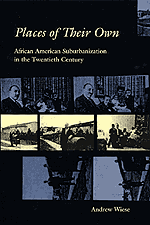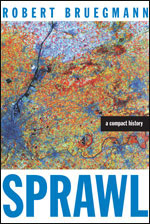Revising the Suburbs
 In an article in the March 24 edition of the Chronicle of Higher Education, reporter Jennifer Howard sees a new wave of scholars challenging the usual wisdom about sprawl and urban growth. Three of our books are discussed in the article.
In an article in the March 24 edition of the Chronicle of Higher Education, reporter Jennifer Howard sees a new wave of scholars challenging the usual wisdom about sprawl and urban growth. Three of our books are discussed in the article.
Places of Their Own: African American Suburbanization in the Twentieth Century by Andrew Wiese is cited as an example of new work being done in suburbs populated by people other than the white middle-class. Wiese says that his project “challenges historians to think and write about suburbs in a different way.” We have an excerpt from his book.
Howard notes that “in 1961 the urban historian Lewis Mumford indicted suburbia as a leveler of the worst order” and that Mumford’s critique is subjected to analysis in our forthcoming collection The New Suburban History (July), edited by Kevin M. Kruse and Thomas J. Sugrue. “The contributors to The New Suburban History focus on the role of African-Americans, other ethnic minorities, and immigrants in the history of suburbanization, as well as on the legal and economic mechanisms that shaped suburban identities and geographies in post-World War II America.”
 Not surprisingly, a lot of room is given over to Robert Bruegmann’s Sprawl: A Compact History. (Read an excerpt on early sprawl.) “Mr. Bruegmann’s approach,” writes Howard, ” leads him to conclusions that tend to fly in the face of received wisdom: for instance, the belief that European cities function in a very different way than American ones do. He likes to surprise people with the fact that in the Paris metropolitan region, famous for its public transportation systems, 80 percent of the trips are made by car.”
Not surprisingly, a lot of room is given over to Robert Bruegmann’s Sprawl: A Compact History. (Read an excerpt on early sprawl.) “Mr. Bruegmann’s approach,” writes Howard, ” leads him to conclusions that tend to fly in the face of received wisdom: for instance, the belief that European cities function in a very different way than American ones do. He likes to surprise people with the fact that in the Paris metropolitan region, famous for its public transportation systems, 80 percent of the trips are made by car.”
Howard concludes: “Suburbia’s revisionist scholars take a long view, literally and figuratively. Their work may help other researchers, city dwellers, and suburbanites find their bearings as they navigate what Mr. Bruegmann calls the ‘terra incognita’ of sprawling metropolitan environments. In the meantime, their work redefines what we talk about when we talk about the suburbs.”